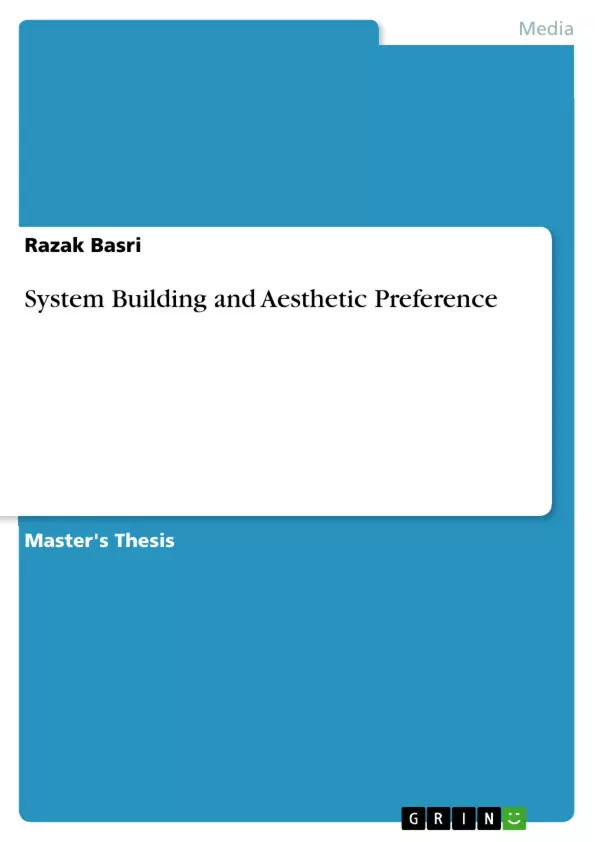This dissertation is concerned with the aesthetics of architecture using system building in housing in the UK. It has been produced in response to a growing level of interest in the system building method and in the aesthetic value of housing schemes constructed using the system building method.
The aim here is to consider research on the system building methods within a house building context and test different types or categories of housing schemes based on aesthetic preference. This study explores issues of perception and level of aesthetic value.
In general, aesthetics is the study of the psychological responses to beauty and artistic experiences.
Aesthetics is the branch of philosophy which deals with the nature of art and of artistic judgment. Some of the central questions of aesthetics focus on the beautiful: under what circumstances it may be said to exist, what criteria are to be used to judge the beautiful, and whether or not these criteria apply equally to literature and music.
There are two traditional views concerning what constitutes aesthetic values. The first finds beauty to be objective, that is, inherent in the entity itself. The second position holds that beauty is subjective, in that it depends on the attitude of the observer. Immanuel Kant argued that judgments of taste, as he called aesthetic judgments, rest on feelings, which, though subjective, have universal validity. The instrumental theory of value, an extension of subjectivism, holds that the value of art consists in its capacity to produce an aesthetic experience (Kristen L. Zacharias).
System building leads to a faster completion period, well organized site, and better quality workmanship and most importantly offers major cost benefits for clients, architects and builders (Basri, 2006). This also means that the construction method is simplified and standardised and ensures good communication between the parties involved (Fergusson, 1981). For the purpose of this study the concept of system building is to be understood in its widest possible context.
Inhaltsverzeichnis (Table of Contents)
- Introduction
- Chapter One - Historical review
- Chapter Two - Current uses
- Systems available
- Benefits of system building
- Key issues in the system building method
- Perceptions of value and aesthetics
- The image of system building
- Flexibility and services
- Procurement
- Chapter Three - Perceptions and attitudes towards system building
- General image
- Perceived performance
- Public expectation
- Perceived value
- System building awareness
- Chapter Four - Aesthetics and Psychology
- Perception
- Aesthetic
- Vagueness
- Vague notions to physical concepts
- Feelings
- Attributes for assessing preference
- Chapter Five - A study examining attitudes towards various house types using system building
- Methodology
- Results
Zielsetzung und Themenschwerpunkte (Objectives and Key Themes)
This thesis explores the relationship between system building and aesthetic preference, focusing on the perception and acceptance of system-built housing in the UK. It aims to identify the key factors influencing aesthetic preference towards system building and analyze how these perceptions are shaped by historical context, current uses, and psychological influences.
- Historical review of system building and its evolution in the UK.
- Analysis of current uses and benefits of system building methods.
- Investigation of public perceptions and attitudes towards system-built housing.
- Exploration of the psychological aspects of aesthetic preference and their relevance to system building.
- Examination of the relationship between system building, design, and user preferences through a study of different house types.
Zusammenfassung der Kapitel (Chapter Summaries)
Chapter One provides a historical review of system building in the UK, tracing its development from early prefab housing to contemporary modular construction. Chapter Two examines the current uses of system building, discussing various available systems, benefits, and key issues. This chapter also explores the perceptions of value and aesthetics associated with system-built structures.
Chapter Three delves into public perceptions and attitudes towards system building, examining the general image, perceived performance, public expectations, perceived value, and awareness of this construction method. Chapter Four explores the psychological aspects of aesthetics and preference, analyzing perception, vagueness, and the relationship between subjective feelings and objective attributes.
Chapter Five presents a study examining attitudes towards various house types using system building. The chapter details the methodology used to conduct the study and presents the results obtained.
Schlüsselwörter (Keywords)
The key focus of this thesis is the relationship between system building, aesthetics, and public perception. It explores concepts like modular construction, prefab housing, design preference, and psychological factors influencing aesthetic judgment. The study examines the historical development of system building, its current uses and benefits, and the perception of value and aesthetics associated with it. The primary objective is to shed light on the influence of system building on architectural design and its impact on public acceptance of such buildings.
- Citation du texte
- Dr. Razak Basri (Auteur), 2007, System Building and Aesthetic Preference, Munich, GRIN Verlag, https://www.grin.com/document/176297



